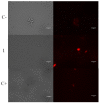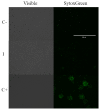Laurequinone, a Lead Compound against Leishmania
- PMID: 37367658
- PMCID: PMC10304164
- DOI: 10.3390/md21060333
Laurequinone, a Lead Compound against Leishmania
Abstract
Among neglected tropical diseases, leishmaniasis is one of the leading causes, not only of deaths but also of disability-adjusted life years. This disease, caused by protozoan parasites of the genus Leishmania, triggers different clinical manifestations, with cutaneous, mucocutaneous, and visceral forms. As existing treatments for this parasitosis are not sufficiently effective or safe for the patient, in this work, different sesquiterpenes isolated from the red alga Laurencia johnstonii have been studied for this purpose. The different compounds were tested in vitro against the promastigote and amastigote forms of Leishmania amazonensis. Different assays were also performed, including the measurement of mitochondrial potential, determination of ROS accumulation, and chromatin condensation, among others, focused on the detection of the cell death process known in this type of organism as apoptosis-like. Five compounds were identified that displayed leishmanicidal activity: laurequinone, laurinterol, debromolaurinterol, isolaurinterol, and aplysin, showing IC50 values against promastigotes of 1.87, 34.45, 12.48, 10.09, and 54.13 µM, respectively. Laurequinone was the most potent compound tested and was shown to be more effective than the reference drug miltefosine against promastigotes. Different death mechanism studies carried out showed that laurequinone appears to induce programmed cell death or apoptosis in the parasite studied. The obtained results underline the potential of this sesquiterpene as a novel anti-kinetoplastid therapeutic agent.
Keywords: Laurencia; Leishmania amazonensis; laurequinone; leishmaniasis; sesquiterpene.
Conflict of interest statement
The authors declare no conflict of interest. The funders had no role in the design of the study; in the collection, analyses, or interpretation of data; in the writing of the manuscript, or in the decision to publish the results.
Figures






Similar articles
-
Efficacy of lapachol on treatment of cutaneous and visceral leishmaniasis.Exp Parasitol. 2019 Apr;199:67-73. doi: 10.1016/j.exppara.2019.02.013. Epub 2019 Feb 21. Exp Parasitol. 2019. PMID: 30797783
-
Monomethylsulochrin isolated from biomass extract of Aspergillus sp. against Leishmania amazonensis: In vitro biological evaluation and molecular docking.Front Cell Infect Microbiol. 2022 Aug 25;12:974910. doi: 10.3389/fcimb.2022.974910. eCollection 2022. Front Cell Infect Microbiol. 2022. PMID: 36093206 Free PMC article.
-
In vitro evaluation of (-)α-bisabolol as a promising agent against Leishmania amazonensis.Exp Parasitol. 2015 Jan;148:66-72. doi: 10.1016/j.exppara.2014.10.001. Epub 2014 Nov 5. Exp Parasitol. 2015. PMID: 25448354
-
Antileishmanial Activities of Medicinal Herbs and Phytochemicals In Vitro and In Vivo: An Update for the Years 2015 to 2021.Molecules. 2022 Nov 4;27(21):7579. doi: 10.3390/molecules27217579. Molecules. 2022. PMID: 36364404 Free PMC article. Review.
-
Natural products derived steroids as potential anti-leishmanial agents; disease prevalence, underlying mechanisms and future perspectives.Steroids. 2023 May;193:109196. doi: 10.1016/j.steroids.2023.109196. Epub 2023 Feb 9. Steroids. 2023. PMID: 36764565 Review.
Cited by
-
Global Health Priority Box: Discovering Flucofuron as a Promising Antikinetoplastid Compound.Pharmaceuticals (Basel). 2024 Apr 25;17(5):554. doi: 10.3390/ph17050554. Pharmaceuticals (Basel). 2024. PMID: 38794125 Free PMC article.
References
-
- World Health Organization Neglected Tropical Diseases (NTDs) 2021. [(accessed on 3 April 2023)]. Available online: https://www.who.int/health-topics/neglected-tropical-diseases#tab=tab_1.
-
- Pan American Health Organization—World Health Organization Leishmaniasis—Fact Sheet for Health Workers. 2017. [(accessed on 3 April 2023)]. Available online: https://www.paho.org/en.
-
- Marinho F.D.E.A., Gonçalves K.C., Oliveira S.S., Oliveira A.C., Bellio M., d’Avila-Levy C.M., Santos A.L., Branquinha M.H. Miltefosine induces programmed cell death in Leishmania amazonensis promastigotes. Mem. Inst. Oswaldo Cruz. 2011;106:507–509. doi: 10.1590/S0074-02762011000400021. - DOI - PubMed
MeSH terms
Substances
Grants and funding
LinkOut - more resources
Full Text Sources
Other Literature Sources
Medical
Research Materials

